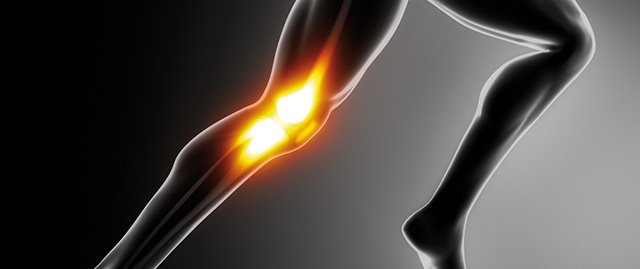Major knee problems
are no match for our team’s expertise

The knee joint
The largest joint in the human body is also the joint that is most commonly operated on. Some of the most common causes for problems are sports injuries, including damage to the meniscus and cruciate ligaments. But each knee is different. Even with our extensive experience, having carried out over 300 knee operations per year, it is not possible to assign standard treatments for the various problems patients suffer from.
Knee problems are demanding from both an orthopaedic and psychological perspective. At ORTHOmedic, we are often able to dispel many of the fears our patients experience as sportspeople with concerns about practising their hobby or professionals who are keen to get back to work. You can count on our team at ORTHOmedic to competently carry out any necessary surgical procedures and provide a comprehensive follow-up treatment.
On this page you will find an overview of the most commonly occurring problems that affect the knee joint. Aside from artificial joint replacements and axial adjustments, all operations are carried out via an arthroscopic procedure. ORTHOmedic is specialised in this minimally invasive procedure. Your expert for knee problems is Professor Schofer.
Torn meniscus
With a moderate tear, the meniscus can be treated by means of a suture anchor repair, for example, which is sufficient to hold the meniscus together. If, however, the meniscus is severely torn, it will need to be removed by means of a partial meniscectomy. To prevent arthrosis, a meniscal transplant procedure may also be carried out. Generally speaking, we carry out this common form of knee surgery via an arthroscopy.
Cartilage refixation and transplantation
If the cartilage becomes detached from the joint as a result of injury (cartilage avulsion), it can be reattached to the joint using bioresorbable pins or screws. A cartilage transplantation involves taking autologous cartilage cells which are then cultivated on a carrier material. This forms a membrane which is inserted into the damaged joint, where the cartilage cells are able to reproduce. The carrier membrane completely dissolves during the healing process without leaving any residue.
Arthrosis
Wear on the joints does not necessarily require an endoprosthesis. If diagnosed early, there are several ways to stop wear and even reverse it. This can be done, for example, by means of microfracture surgery. During this procedure, the bone is drilled in multiple places. The blood clots that occur as a result contain stem cells, which develop into fibrocartilage that covers the joint surface. Gradually, a stable and resilient replacement cartilage is formed.
Osteochondronecrosis (bone loss)
This form of knee disease is particularly insidious because its exact cause is unknown and its onset often painless, which leads to late diagnosis. If deterioration of cartilage or bone density is diagnosed early enough, the process can often be stopped. To do this, the area where the bone is deteriorating is drilled in order to trigger new bone growth.
Reconstruction of the cruciate ligament
A torn cruciate ligament is the most common of all knee diseases. It is a classic sports injury that can often be prevented by physical therapy. Torn cruciate ligaments can be sewn together, while completely severed ligaments often have to be replaced. At ORTHOmedic, we typically carry out this procedure by taking a graft from the semitendinosus tendon in the hamstring. The transplant is adapted to fit the area exactly and inserted into the knee joint before it is fixed inside the bone using a special resorbable screw.
Patellar luxation (dislocation)
Luxation of the patellar occurs when the knee cap moves out of its usual location. One of the ways of treating this is through stabilisation of the knee cap. The inner capsule of the knee joint is sewn together and strengthened. This stabilises the knee cap to prevent any further dislocations.
Osteotomy (axial adjustment)
Axial adjustment procedures are a well-established, tried and tested procedure for treating arthrosis that occurs on one side of the knee joint, as well as misalignments of the knees, for example bowed legs. First of all, the knee is examined by means of an arthroscopy. An axial adjustment is then carried out using a cutting-edge procedure known as ‘open wedge’, and a titanium implant is inserted.

